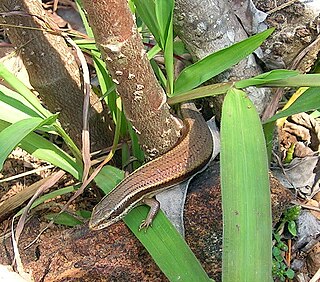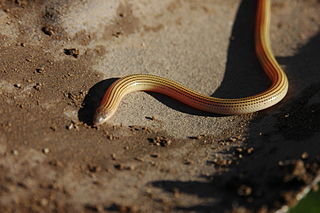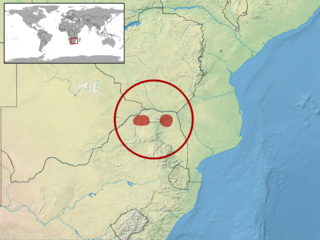Acontias is a genus of limbless skinks, the lance skinks, in the African subfamily Acontinae. Most are small animals, but the largest member of the genus is Acontias plumbeus at approximately 40 cm (16 in) snout-vent length. All members of this genus are live-bearing sandswimmers, with fused eyelids. A recent review moved species that were formerly placed in the genera Typhlosaurus, Acontophiops, and Microacontias into this genus, as together these form a single branch in the tree of life. This new concept of Acontias is a sister lineage to Typhlosaurus, and these two genera are the only genera within the subfamily Acontinae.

Typhlosaurus is a genus of African lizards, one of a number of genera of limbless lizards in the skink family (Scincidae). This group was recently revised with most species formerly attributed to Typhlosaurus now placed in Acontias. The current definition of Typhlosaurus includes five attenuate body legless lizards from southwestern Africa. This is the sister genus to Acontias, which together form the well supported Afrotropical subfamily Acontinae.

Acontias breviceps, the shorthead lance skink or shortheaded legless skink, is a species of viviparous, legless, fossorial lizards occurring along the southern and eastern sections of the Great Escarpment in South Africa. It may grow up to 10 cm long.

Acontias percivali, also known commonly as Percival's lance skink, Percival's legless lizard, and the Tanzanian legless lizard, is a species of small, legless (snake-like) lizard in the family Scincidae. The species is endemic to Africa.

Legless lizard may refer to any of several groups of lizards that have independently lost limbs or reduced them to the point of being of no use in locomotion. It is the common name for the family Pygopodidae. These lizards are often distinguishable from snakes on the basis of one or more of the following characteristics: possessing eyelids, possessing external ear openings, lack of broad belly scales, notched rather than forked tongue, having two more-or-less-equal lungs, and/or having a very long tail.

The woodbush legless skink is a species of legless skink. It is found in the Wolkberg mountains of Limpopo Province, South Africa. Females of the species give birth to live young. This lizard species was formerly placed in a monotypic genus as Acontophiops lineatus. Morphologically the genus shows similarities to Acontias cregoi and a recent review placed both of these within the genus Acontias, which, as Acontias lineatus was already occupied, required a new name for this species.
Kasner's dwarf burrowing skink, also known commonly as Kasner's burrowing skink, is a species of lizard in the family Scincidae.

Lygosominae is the largest subfamily of skinks in the family Scincidae. The subfamily can be divided into a number of genus groups. If the rarely used taxonomic rank of infrafamily is employed, the genus groups would be designated as such, but such a move would require a formal description according to the ICZN standards.

Acontias gracilicauda, the slendertail lance skink or thin-tailed legless skink, is a species of skink. It is found in the Republic of South Africa and Lesotho. Acontias namaquensis was formerly included in this species as a subspecies, but is now recognized as a distinct species.
Acontias albigularis, the white-throated legless skink, is a species of lizard in the family Scincidae. It is endemic to South Africa.
Acontias aurantiacus, the golden blind legless skink, is a species of lizard in the family Scincidae. It is found in Zimbabwe, Mozambique, Botswana, and South Africa.

Acontias cregoi, commonly known as Cregoe's legless skink, Cregoi's blind legless skink, and Cregoi's legless skink, is a species of lizard in the family Scincidae. The species is endemic to South Africa.
Acontias fitzsimonsi, Fitzsimons' legless skink or Fitzsimon's legless skink, is a species of lizard in the family Scincidae. It is endemic to South Africa.
Acontias namaquensis, the Namaqua legless skink or Namaqua lance skink, is a species of lizard in the family Scincidae. It is endemic to Little Namaqualand, Northern Cape, South Africa.

Acontias orientalis, the Eastern striped blindworm or Eastern Cape legless skink, is a species of lizard in the family Scincidae. It is endemic to South Africa.

Acontias plumbeus, the giant legless skink or giant lance skink, is a species of lizard in the family Scincidae. It is found in South Africa, Eswatini, Mozambique, and Zimbabwe.

Acontias richardi, Richard's legless skink, is a species of lizard in the family Scincidae. It is endemic to South Africa.
Acontias wakkerstroomensis, the Wakkerstroom legless skink, is a species of lizard in the family Scincidae. It is endemic to South Africa.
Haacke's legless skink, also known commonly as Brain's legless skink and Brain's blind legless skink, is a species of lizard in the family Scincidae. The species is endemic to Namibia.

The southern blind legless skink or Cuvier's legless skink is a species of lizard in the family Scincidae. The species is endemic to South Africa.











